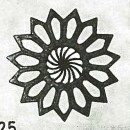Discoaster splendidus
Set number: 1793
-
1
-
2
-
3
-
4
-
5
-
6
-
7
-
8
-
9
-
10
-
11
-
12
-
13
-
14
-
15
-
16
-
17
-
18
-
19
-
20
10µm
Set number: 1794
-
1
-
2
-
3
-
4
-
5
-
6
-
7
-
8
-
9
-
10
10µm
Set number: 1795
-
1
-
2
-
3
-
4
-
5
-
6
-
7
-
8
-
9
-
10
-
11
-
12
-
13
-
14
-
15
-
16
-
17
-
18
10µm
Set number: 1792
-
1
-
2
-
3
-
4
-
5
-
6
-
7
-
8
10µm
Set number: 1796
-
1
-
2
-
3
-
4
-
5
-
6
-
7
-
8
10µm
Set number: 1797
-
1
-
2
-
3
-
4
-
5
-
6
10µm
Discoaster splendidus Martini, 1960
Discoaster helianthus Bramlette & Sullivan, 1961
The rosette-shaped Discoaster, often likened to a sunflower due to its appearance, is characterised by 11-15 segments that are typically joined along more than half of their length. When observed in a mobile mount, it becomes evident that both sides of the central area are adorned with large but shallow processes. Notably, the central process on the concave side is larger than the one on the convex side.
The holotype of this Discoaster was recorded from the Middle Oligocene (Rupelian stage). In the current study, it is considered to be reworked, indicating that the specimen has been redeposited into younger sediments after its initial burial.
Bramlette, M. N. & Sullivan, F. R. 1961, Coccolithophorids and related nannoplankton of the Early Tertiary in California. Micropaleontology 7(2): 129-188.
Martini, E. 1960. Braarudosphaeriden, Discoasteriden und verwandte formen aus dem Rupelton des Mainzer Beckens. Notizbl. hess. L-Amt Bodenfoch. 88: 65-87.


